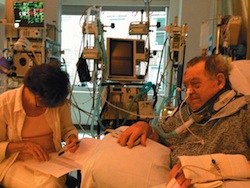Surprisingly, the eminent Arnold Relman — physician, researcher, author, former Harvard professor and editor in chief of the New England Journal of Medicine who frequently speaks out about what’s wrong with the U.S. health care system — only recently discovered the value of nursing.
Last year, at age 90, Dr. Relman fell down stairs in his home cracking his skull and breaking three vertebrae in his neck and several bones in his face. By the time he arrived in the emergency room, blood was pressing down on his windpipe and flowing into his brain. His heart stopped three times, and resuscitation efforts broke several ribs.

Arnold Relman in the surgical intensive care unit at Massachusetts General Hospital, the week after his accident. His wife, Marcia Angell, is helping him correct galleys of his August 15, 2013, article in the New York Review of Books, “Obamacare: How It Should Be Fixed.”
Astonishingly, he survived, and with mental function intact. He wrote about his 10-week experience in hospitals in the Feb. 6 issue of The New York Review of Books. He reported that the nursing care in his 11 days in the intensive care unit was consistently excellent, but in the rehabilitation hospital, it was often inadequate.
“I had never before understood how much good nursing care contributes to patients’ safety and comfort, especially when they are very sick or disabled,” he admitted. “When nursing is not optimal, patient care is never good.”
He also wrote, “This is a lesson all physicians and hospital administrators should learn.” Yes, indeed it is.
Perhaps it’s because Relman spent most of his career in academia that he didn’t have his epiphany until he was brought face-to-face with death as a helpless patient. Nurses are with patients 24/7, and we are all about keeping them comfortable, meeting their needs and staying alert to any change in condition. In more than 30 years of neonatal intensive care nursing, I don’t know any doctors — or parents — who do not fully grasp the connection between optimal nursing care and good patient outcomes.
As for hospital administrators, they must understand that people come to the hospital for nursing care and that nurses are the backbone of the hospital. Those who have had Relman’s late-in-life discovery will understand that a job priority is to ensure that nurses have what they need to provide excellent care.
The recently deceased and visionary Sister Mary Rose McPhee, chief executive officer of what’s now Seton Medical Center Austin from 1976 to 1982, was one of the first hospital administrators in the country to name a nurse to an executive-level position. She knew that for nurses to be able to nurture their patients, they must themselves be nurtured.
She knew that a strong nurse executive with extensive clinical background would help ensure optimal nurse staffing, which would lead to happy nurses, happy doctors and happy, safe patients. Her hunch was externally validated when the American Nurses Credentialing Center named her hospital one of the original 41 Magnet hospitals in the 1980s, an honor bestowed for nursing excellence in patient care.
Health care reform is a time of uncertainty for hospitals, especially in states not expanding Medicaid, like Texas, and many hospitals are implementing austerity measures to minimize expenditures. If hospital leaders (and consultants) have not learned Relman’s lesson, they may simply view nursing as a giant operating expense on the left side of the ledger and correct staffing levels downward. But that’s a short-sighted and dangerous road to go down.
For 40 years, study after study has shown that even modest decreases in nurse staffing significantly increase a hospital’s patient morbidity and mortality. The latest, published in February in the British medical journal The Lancet, studied close to a half million surgical patients and more than 26,000 nurses in 300 hospitals in nine European countries. It found a 7 percent increase in deaths for every one patient increase in a nurse’s workload. Dr. Relman would raise a glass to this study.

 Austin, Texas
Austin, Texas